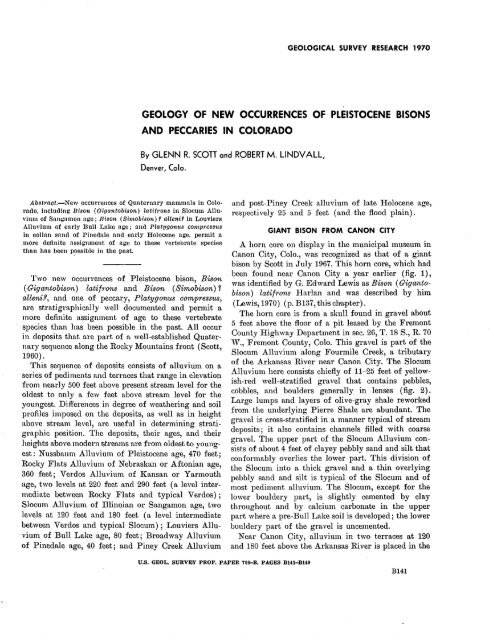RESEARCH· ·1970·
RESEARCH· ·1970·
RESEARCH· ·1970·
You also want an ePaper? Increase the reach of your titles
YUMPU automatically turns print PDFs into web optimized ePapers that Google loves.
GE,OLOGICAL SURVEY RESEA·RCH 1970<br />
GEOLOGY OF NEW OCCURRENCES OF PLEISTOCENE BISONS<br />
AND PECCARIES IN COLORADO<br />
By GLENN R. SCOTT and ROBERT M. LINDY ALL,<br />
Denver, Colo.<br />
A.bstt·aot.-New occurrences of Quaternary mammals in Colorado,<br />
including Bison ( G-irJantolJison) la,ti.ft·ons in Slocum Alluvium<br />
of Snngnmon nge; B'ison (Shnob1son) P alleniP in Louviers<br />
Alluvium of enrly Bull T.Jnke age; nnd Platygon1t8 cotnpt·essus<br />
in eolinn snnd of Pineclnle and early Holocene age, permit a<br />
more definite assignment of age to these vertebrate species<br />
thnn hns been possible in the pnst.<br />
Two new occurrences of Pleistocene bison, Bison<br />
(-Gigantobison) latif'rons and Bison (Simobison) ?<br />
alleni.~, and one of peccary, Platygonus compressus,<br />
are stratigraphically well documented and permit a<br />
more definite assignment of age to these vertebrate<br />
species than has been possible in the past. All occur<br />
in deposits that are part of a well-established Quaternary<br />
sequence along the Rocky l\1ountains front (Scott,<br />
1960).<br />
'"!''his sequence of deposits consists of alluvium on a<br />
series of pediments and terraces that range in elevation<br />
from nearly 500 feet above present stream level for the<br />
oldest to only a :few feet above stream level for the<br />
youngest. Differences in degree of weathering and soil<br />
profiles imposed on the deposits, as well as in height<br />
above stream level, ~tre useful in determining stratigraphic<br />
position. The deposits, their ages, and their<br />
heights above modern 'Streams ~we fr01n oldest Ito youngest:<br />
Nussbaum Alluvium of Pleistocene age, 470 feet;<br />
Rocky Flnts Alluvium of Nebraskan or Aftonian age,<br />
360 feet; Verdos Alluvium of J(ansan or Yarmouth<br />
age, two levels ttt 220 feet and 290 feet (a level intermediate<br />
between Rocky Flats and typical Verdos) ;<br />
Slocmn Alluvium of Illinoian or Sangamon age, two<br />
levels at 120 feet and 180 feet (a level intermediate<br />
between Verdos nnd typical Slocmn); Louviers Alluvium<br />
of Bull Lake age, 80 feet; Broadway Alluvium<br />
of Pinedale age, 40 feet; and Piney Creek Alluvium<br />
and post-Piney Creek alluvium of late Holocene age,<br />
respectively 25 and 5 feet ( nnd the flood plain) .<br />
GIANT BISON FROM CANON CITY<br />
A horn core on display in the municipal museum in<br />
Canon City, Colo., was recognized as that of a giant<br />
bison by Scott in July 1967. This horn core, which had<br />
been found near Canon City a year earlier (fig. 1),<br />
was identified by G. Edward Lewis as Bison ( Gigantobison)<br />
latif'rons Harlan and was described by him<br />
(Lewi's, 1970) (p. B137, tJhis chapter).<br />
The horn core is from a skull found in gravel about<br />
5 feet above the floor of a pit leased by the Fremont<br />
County Highway Department in sec. 26, T. 18 S., R. 70<br />
"V., Fremont County, Colo. This gravel is part of the<br />
Slocum Alluvium along Fourmile Creek, a tributary<br />
of the Arkansas River near Canon City. The Slocum<br />
Alluvium here consists chiefly of 11-25 feet of yellowish-red<br />
well-stratified gravel that contains pebbles,<br />
cobbles, and boulders generally in lenses (fig. 2).<br />
Large lumps and layers of olive-gray shale reworked<br />
from the underlying Pierre Shale are abundant. The<br />
gravel is cross-stratified in. a manner typical of stream<br />
deposits; it also contains channels filled with coarse<br />
gravel. The upper part of the Slocum Alluvium consists<br />
of about 4 feet of clayey pebbly sand and silt that<br />
conformably overlies the lower part. This division of<br />
the Slocum into a thick gravel and a thin overlying<br />
pebbly sand and silt is typical of the Slocum and of<br />
most pediment alluvium. The Slocum, except for the<br />
lower bouldery part, is slightly cemented by clay<br />
throughout and by calcium carbonate in the upper<br />
part where a pre-Bull Lake soil is developed; the lower<br />
bouldery part of the gravel is uncemented.<br />
Near Canon City, ·alluvium in two terraces at 120<br />
and 180 feet above the Arkansas River is placed in the<br />
lJ.S. GEOL. SURVEY PROF. PAPER 70G-B, PA:GES Bl41-Bl49<br />
B141
















